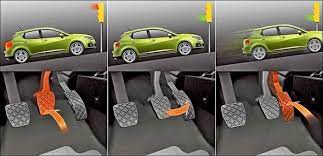
Как работает система помощи при подъеме
Содержание
Плотное городское движение и поездки в горной местности требуют от водителя крайней бдительности, особенно на участках с уклонами. Хотя опытные автомобилисты должны без проблем трогаться с места, но проблема отката машины на горке является распространенной причиной аварий. Решением проблемы стала система помощи при подъеме, которая должна подстраховывать начинающих и потерявших бдительность водителей.
Что такое система помощи при подъеме
Современные автопроизводители направляют максимум усилий на создание безопасного транспорта путем внедрения в конструкцию различных систем активной безопасности. Одной из них является система помощи при подъеме. Ее суть заключается в том, чтобы не дать автомобилю откатиться вниз, когда водитель отпустил педаль тормоза на уклоне.
Основное известное решение — Hill-Start Assist Control (HAC или HSA). Она поддерживает давление в тормозных контурах после того, как водитель убрал ногу с педали. Это позволяет продлить период работы тормозных колодок и обезопасить старт на подъеме.
Работа системы сводится к автоматическому определению уклонов и использованию тормозной системы. Водителю больше не нужно применять ручной тормоз или заботиться о дополнительной безопасности при движении вверх.
Основное назначение и функции
Основное назначение заключается в предотвращении отката автомобиля на уклоне после начала движения. Неопытные водители могут забыть об особенностях езды при подъеме, в результате чего машина покатится вниз, что может вызвать ДТП. Если говорить о функциональных особенностях HAC, стоит выделить следующие:
- Определение угла наклона автомобиля — если показатель больше 5%, система начинает автоматически работать.
- Контроль тормозов — если машина остановилась и после этого начинается движение, система поддерживает давление в тормозных механизмах, чтобы обеспечить безопасность старта.
- Контроль оборотов двигателя — когда крутящий момент достигает необходимого уровня, тормоза ослабевают и автомобиль начинает движение.
Система отлично справляется с работой в нормальных условиях, а также помогает автомобилю при гололеде и бездорожье. Дополнительное преимущество — предотвращение обратного скатывания под силой тяжести или при сильном уклоне.
Конструктивные особенности
Для интеграции решения в автомобиль не требуется никаких дополнительных конструктивных элементов. Работоспособность обеспечивается с помощью программного обеспечения и прописанной логики действий блока ABS или ESP. Внешних отличий у автомобиля с HAS также нет.
Функция помощи при подъеме должна исправно работать даже в том случае, если автомобиль движется вверх задним ходом.
Принцип и логика работы
Система в автоматическом режиме определяет угол уклона. Если он превышает 5% – запускается автоматический алгоритм действий. Работает этот таким образом, что после отпускания педали тормоза HAS поддерживает давление в системе и предотвращает откат. Существует четыре основных этапа работы:
- водитель нажимает на педаль и создает давление в системе;
- удержание давления с помощью команд от электроники;
- постепенное ослабление тормозных колодок;
- полный сброс давления и начало движения.
Практическая реализация работы системы аналогична работе системы АБС. Более подробно об этом можно почитать в нашей статье. Когда водитель нажимает на педаль тормоза, в тормозной системе повышается давление и срабатывают тормозные механизмы колес. Система фиксирует уклон и автоматически закрывает впускные и выпускные клапаны в гидроблоке ABS. Таким образом, происходит удержание давления в тормозных контурах и если водитель уберет ногу с педали тормоза – автомобиль останется неподвижен.
В зависимости от производителя, время удержания автомобиля на уклоне может быть ограничено (около 2 сек.).
Когда водитель нажимает на педаль газа, система начинает постепенно открывать выпускные клапаны в гидроблоке. Давление начинает снижаться, но все еще позволяет предотвратить скатывание вниз. Когда двигатель набирает нужный крутящий момент, клапаны полностью открываются, давление сбрасывается, и колодки полностью отпускаются.
Похожие разработки у разных производителей
Большинство мировых компаний заботится о внедрении новинок в транспортные средства и повышении комфорта движения. Для этого на вооружение берутся все разработки, предназначенные для безопасности и удобства водителей. Первопроходцем в создании HAC стала компания Toyota, которая показала миру возможности старта на уклоне без дополнительных действий. После этого система начала появляться и у других производителей.
| HAC, Hill-Start Assist Control | Toyota |
| HHC, Hill Hold Control | Volkswagen |
| Hill Holder | Fiat, Subaru |
| USS, Uphill Start Support | Nissan |
Хотя у систем разные названия и может незначительно отличаться логика работы, суть решения сводиться к одному. Использование помощи при подъеме позволяет без лишних действий увеличивать скорость транспортного средства, не опасаясь угрозы отката назад.

